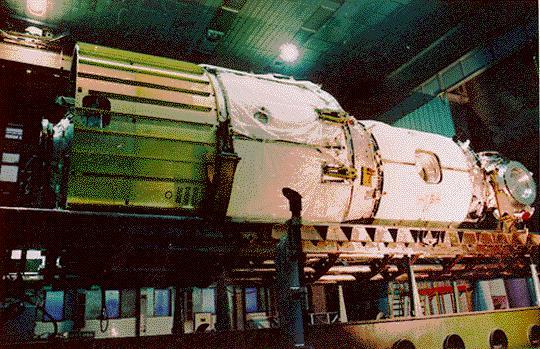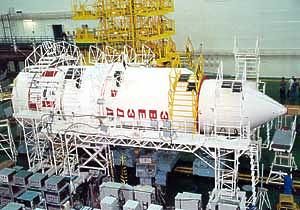ISS Zvezda (original) (raw)

Home - Search - Browse - Alphabetic Index: 0- 1- 2- 3- 4- 5- 6- 7- 8- 9
A- B- C- D- E- F- G- H- I- J- K- L- M- N- O- P- Q- R- S- T- U- V- W- X- Y- Z
ISS Zvezda

Service Module
Service Module in shop
Credit: NASA
Russian manned space station module. The Zvezda service module of the International Space Station had its origins a quarter century before it was launched. Built by GKNPTs Khrunichev for Rosaviakosmos, Russia. Launched 2000.
AKA: Alpha-SM;USM No. 176-01;USM No. 176-01;DOS 8;Zvezda;SM. Status: Operational 2000. First Launch: 2000-07-12. Last Launch: 2000-07-12. Number: 1 . Gross mass: 20,000 kg (44,000 lb).
The Mir-2 space station was originally authorized in the February 1976 resolution setting forth plans for development of third generation Soviet space systems. It would undergo many changes over the years, with only one thing remaining constant: the starting point was always the DOS-8 base block space station core module, built as a back-up to the DOS-7 base block used in the Mir station. When the International Space Station was agreed to, the $3-billion DOS-8 became the first Russian segment of the station, originally known as the Service Module.
The original plan called for a first launch in June 1997 of the ISS Zarya tug followed by the Russian Service Module in September. ISS would then be permanently manned from January 1998 onwards. This launch schedule was delayed by more than two years due to Russia's economic problems.
DOS-8 serial number 128 was originally designed to have a three year service life in space. This was later increased to five years. The spaceframe was completed in February 1985 and major internal equipment was installed by October 1986. Until Reagan's 1983 announcement of the Star Wars program, Mir-2 was to be a relatively modest station, a near-duplicate of Mir assembled after the end of its planned five year life.
The decision by Soviet Premier Andropov to compete with America in military dominance from space lead to a huge expansion of Soviet space station plans. As design continued the station grew to immense proportions. The draft project for this greatly expanded station was approved by NPO Energia Chief Semenov on 14 December 1987 and announced to the press as 'Mir-2' in January 1988. The station would be built in a 65 degree orbit and consist mainly of enormous 90 metric ton modules. But the first launch, as always, was the DOS 8. Assembly of the station was expected to begin in 1993.
As the Soviet Union disintegrated plans for this station were scaled down. By 1991 the Energia modules were out of the picture and the drastically reduced 'Mir 1.5', was under consideration. DOS-8 would be equipped by Buran with 37KBE power modules and two operational 37KBT biotechnology modules. By 1992 Buran was now out of the picture and the plan was reduced in scale again. These revised plans were approved by the Council of Chief Designers on 24 November 1992. Mir-2 would now consist of the DOS-8 core module, and a cross beam called the NEP (scientific-energy platform). The add-on modules were reduced in size for launch by either the Soyuz or Zenit launch vehicles.
By November 1992 further financial difficulties and uncertainties with America's Freedom space station led Russia and the European Space Agency to open discussions on joint development and use of Mir-2. This circle was expanded in the summer of 1993 when Energia briefed NASA on the Mir-2. Finally in November 1993 Freedom, Mir-2, and the European and Japanese modules were incorporated into a single International Space Station. Among these was the Alpha Service Module - the DOS-8 station, finally to be launched as the second major ISS module during 2000.
Improved space transportation capabilities were a major reason for bringing the Russians on board. NASA decided to use the existing 3-man Soyuz spacecraft as an interim 'lifeboat' for the Space Station while investigating more capable alternatives. The Russians also promised to provide -- and pay for -- cheap unmanned cargo transportation. However, the modified Progress M and MT versions were never built. Russia still committed to launch four standard Progress craft per year, but many Western observers doubted that the Russians would be able to deliver on those promises. The Russian Space Agency was strapped for cash and keeping the existing Mir space station in orbit until 2001 further drained resources from the International Space Station.
Many ISS elements were also moved from Russian rockets to the US Space Shuttle as Russia's commitments to the station declined. The originally-planned Russian laboratory modules were replaced with larger FGB-derived design to save money. Boeing and Khrunichev announced in July 2000 that they would build a privately financed module, the 'Commercial Space Module', based on the FGB design and launched as early as 2002. The small Russian laboratory modules, Science and Power Platform, and most of the other components planned by the Russians were derived from the old 'Mir 1.5' plan. All of these Russian modules, except use of Soyuz and Progress spacecraft for station resupply, were in question by early 2001.
More at: ISS Zvezda.
Family: Space station, Space station orbit, USA - Space Stations. Country: Russia. Spacecraft: ISS. Launch Vehicles: Proton, Proton-K. Launch Sites: Baikonur, Baikonur LC81/23. Agency: Korolev bureau. Bibliography: 2, 3508, 3514, 552, 554, 7, 8, 6604.
Photo Gallery
 |
ZvezdaCredit: Energia |
|---|
 |
ZvezdaCredit: Manufacturer Image |
|---|
1985 February - .
- DOS-8 structure completed. - . Nation: Russia. Spacecraft: ISS, ISS Zvezda, Mir-2. DOS-8 serial number 128 was originally designed as the backup to Mir and possibly the core module of Mir-2..
1986 October - .
- DOS-8 major equipment installation complete. - . Nation: Russia. Spacecraft: ISS, ISS Zvezda, Mir-2. DOS-8 serial number 128 was originally designed as the backup to Mir and possibly the core module of Mir-2..
1987 December 14 - .
- Mir-2 draft project approved - . Nation: Russia. Spacecraft: ISS, ISS Zvezda, Mir-2.
The draft project for this greatly expanded station was approved by NPO Energia Chief Semenov on 14 December 1987 and announced to the press as 'Mir-2' in January 1988. The station would be built in a 65 degree orbit and consist mainly of enormous 90 tonne modules. But the first launch, as always, was the DOS 8. Assembly of the station was expected to begin in 1993.
1992 November 24 - .
- Council of Chief Designers review revised Mir-2 design - . Nation: Russia. Spacecraft: ISS, ISS Zvezda, Mir-2.
With abandonment of the Buran shuttle and 37K modules, the Mir-2 design was cut back again. Mir-2 returned to its original planned 65 degree orbit, and would be assembled and flown separately from Mir. It would now consist of the DOS-8 core module, and a cross beam called the NEP (scientific-energy platform). This was equipped with equipment already proven on Mir: MSB retractable solar panels, Sfora thruster packages, small scientific packages as demonstrated on Kvant.The add-on modules now used the Progress-M service module as a tug, and were reduced in size for launch by either the Soyuz or Zenit launch vehicles.
2000 July 12 - . 04:56 GMT - . Launch Site: Baikonur. Launch Complex: Baikonur LC81/23. LV Family: Proton. Launch Vehicle: Proton-K.
- Zvezda - . Mass: 20,295 kg (44,742 lb). Nation: Russia. Agency: RAKA. Manufacturer: Chelomei bureau, Korolev bureau. Program: ISS. Class: Manned. Type: Manned space station. Spacecraft Bus: ISS. Spacecraft: ISS Zvezda. USAF Sat Cat: 26400 . COSPAR: 2000-037A. Apogee: 332 km (206 mi). Perigee: 179 km (111 mi). Inclination: 51.60 deg.
Years behind schedule, the Zvezda living module of the International Space Station, built and financed by Russia, finally reached orbit. Zvezda's initial orbit was 179 x 332 km x 51.6 deg. On July 14 the orbit was raised to 288 x 357 km. ISS was then in a 365 x 372 km orbit. After matching orbits with the ISS, Zvezda then became the passive docking target for the Russian-built, US-financed Zarya module already attached to the station. The Zarya/Unity stack docked with the Zvezda module at 00:45 GMT on July 26, forming the basic core of the International Space Station. A flood of NASA missions would follow to bring the station into operation.
Home - Search - Browse - Alphabetic Index: 0- 1- 2- 3- 4- 5- 6- 7- 8- 9
A- B- C- D- E- F- G- H- I- J- K- L- M- N- O- P- Q- R- S- T- U- V- W- X- Y- Z
© 1997-2019 Mark Wade - Contact
© / Conditions for Use